外研版七年级下册 Module 8 Story time 模块复习课件 (共51张PPT)
文档属性
| 名称 | 外研版七年级下册 Module 8 Story time 模块复习课件 (共51张PPT) | 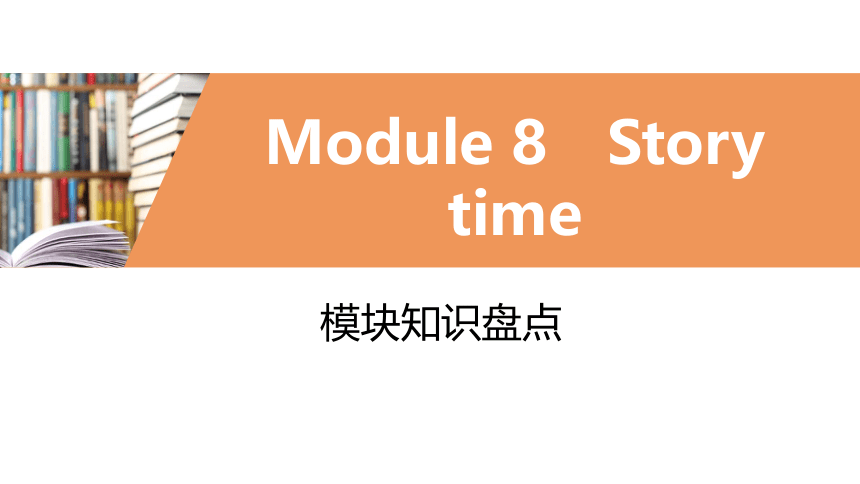 | |
| 格式 | pptx | ||
| 文件大小 | 453.0KB | ||
| 资源类型 | 教案 | ||
| 版本资源 | 外研版 | ||
| 科目 | 英语 | ||
| 更新时间 | 2022-08-27 21:48:37 | ||
图片预览

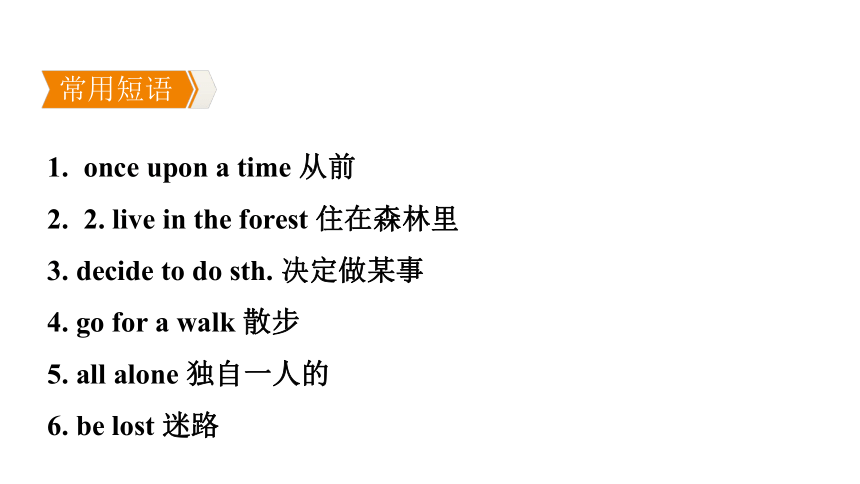
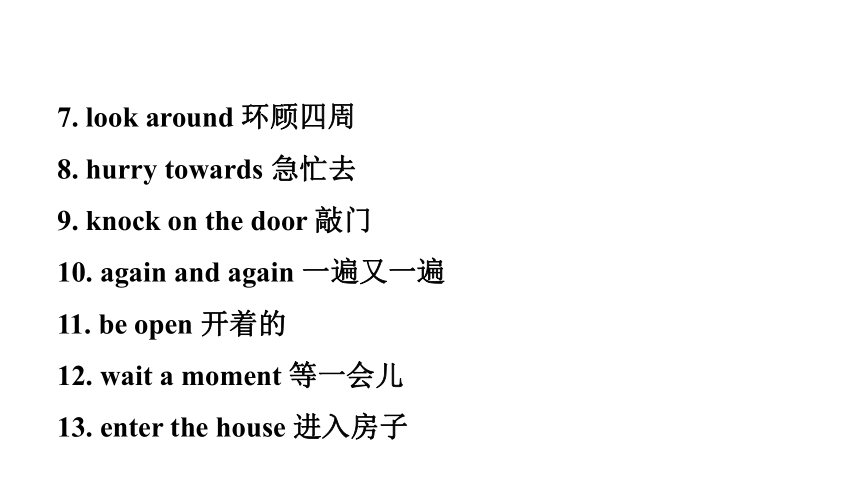
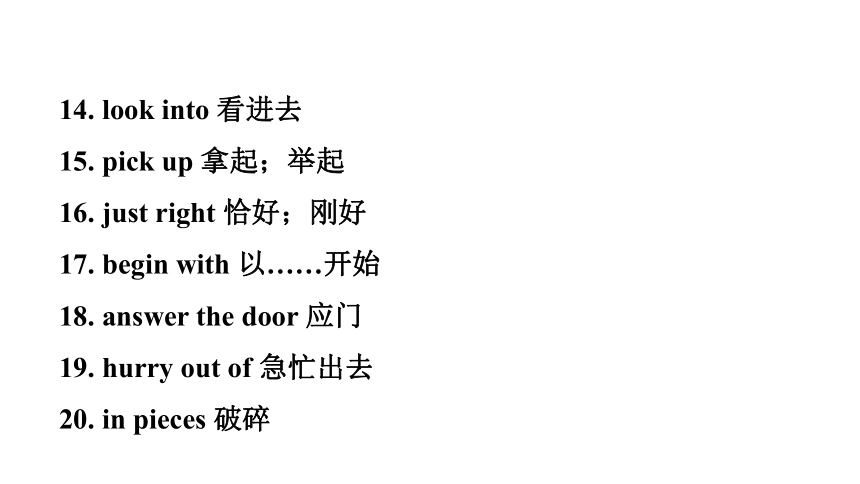

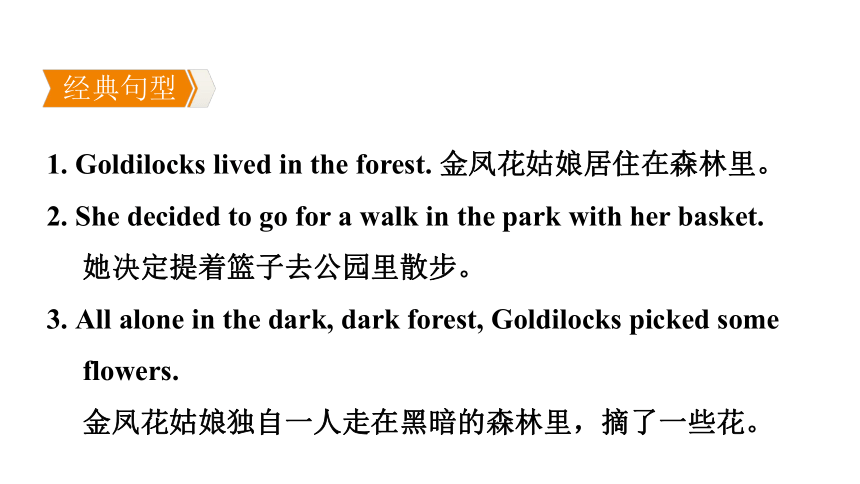

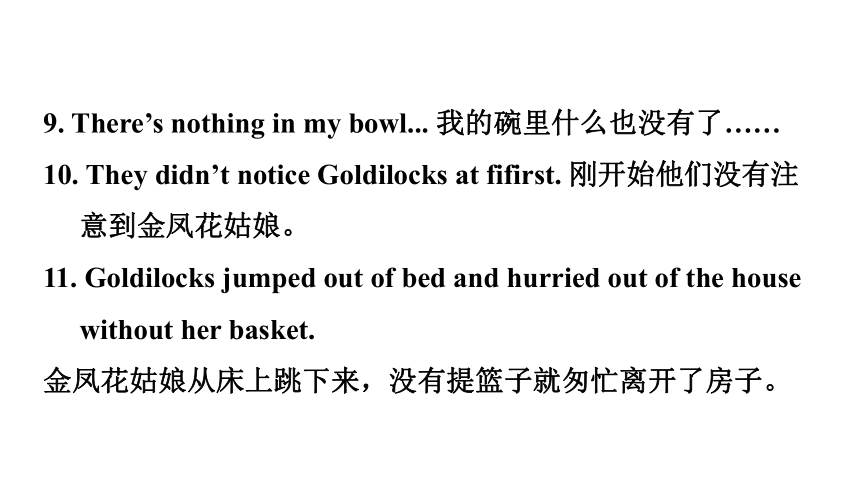
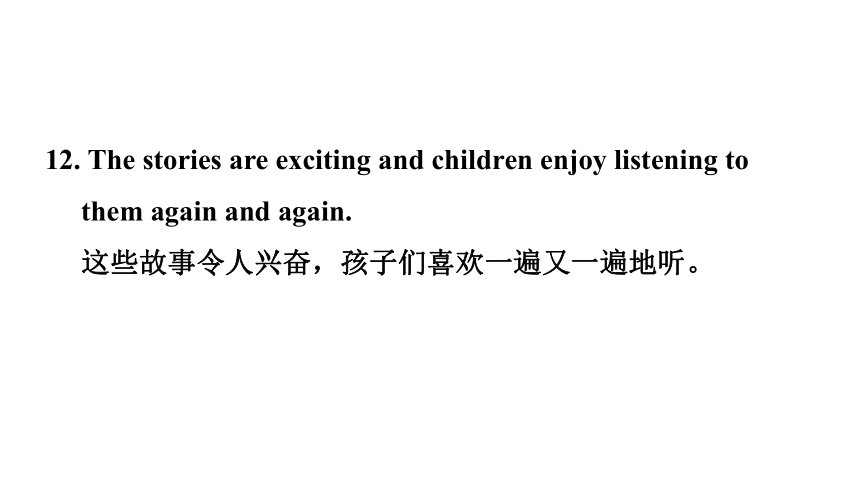

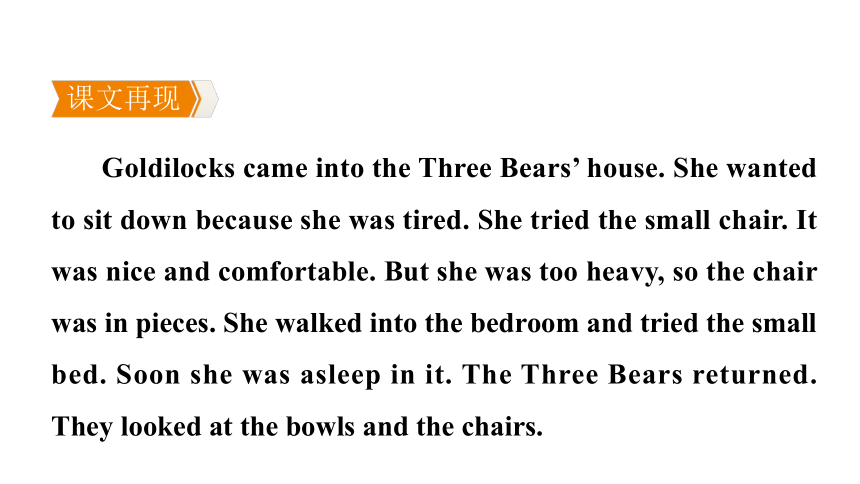
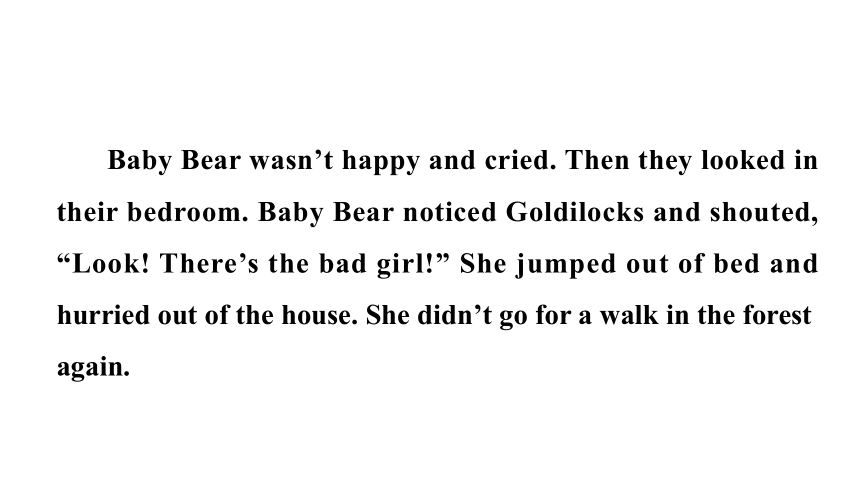
文档简介
(共51张PPT)
Module 8 Story time
模块知识盘点
常用短语
once upon a time 从前
2. live in the forest 住在森林里
3. decide to do sth. 决定做某事
4. go for a walk 散步
5. all alone 独自一人的
6. be lost 迷路
7. look around 环顾四周
8. hurry towards 急忙去
9. knock on the door 敲门
10. again and again 一遍又一遍
11. be open 开着的
12. wait a moment 等一会儿
13. enter the house 进入房子
14. look into 看进去
15. pick up 拿起;举起
16. just right 恰好;刚好
17. begin with 以……开始
18. answer the door 应门
19. hurry out of 急忙出去
20. in pieces 破碎
21. be asleep 睡着
22. return to 回到
23. at first 起初;首先
24. point at 指着……
25. jump out of bed 跳下床
26. enjoy doing sth. 喜欢做某事
经典句型
1. Goldilocks lived in the forest. 金凤花姑娘居住在森林里。
2. She decided to go for a walk in the park with her basket.
她决定提着篮子去公园里散步。
3. All alone in the dark, dark forest, Goldilocks picked some flowers.
金凤花姑娘独自一人走在黑暗的森林里,摘了一些花。
4. ... so she hurried towards it, and knocked on the door.
……于是她匆忙跑向那里,敲了敲门。
5. Finally, she pushed the door. 最后,她推了推门。
6. Goldilocks entered the house and looked into a small room.
金凤花姑娘进了房子,朝一个小房间里看了看。
7. She finished all the food in it. 她吃完了里面所有的食物。
8. Goldilocks wanted to sit down because she was tired. 金凤花姑娘想坐下,因为她累了。
9. There’s nothing in my bowl... 我的碗里什么也没有了……
10. They didn’t notice Goldilocks at fifirst. 刚开始他们没有注意到金凤花姑娘。
11. Goldilocks jumped out of bed and hurried out of the house without her basket.
金凤花姑娘从床上跳下来,没有提篮子就匆忙离开了房子。
12. The stories are exciting and children enjoy listening to them again and again.
这些故事令人兴奋,孩子们喜欢一遍又一遍地听。
掌握规则动词的一般过去时的各种句式。
语法点睛
课文再现
Goldilocks came into the Three Bears’ house. She wanted to sit down because she was tired. She tried the small chair. It was nice and comfortable. But she was too heavy, so the chair was in pieces. She walked into the bedroom and tried the small bed. Soon she was asleep in it. The Three Bears returned. They looked at the bowls and the chairs.
Baby Bear wasn’t happy and cried. Then they looked in their bedroom. Baby Bear noticed Goldilocks and shouted, “Look! There’s the bad girl!” She jumped out of bed and hurried out of the house. She didn’t go for a walk in the forest again.
模块专题聚焦
巧品语法
语法精讲
一般过去时(2)
命题情报
中考题中对行为动词的一般过去时的考查重点是掌握规则动词的过去式的变化规律。
意义 (1) 表示主语在过去“做”了什么事,侧重于动作或行为已经成为过去了。
We saw a film last night.
昨晚我们看了一场电影。
(2) 表示过去连续发生的一连串的动作。
My sister had breakfast, and then she went
to school. 我妹妹吃完早餐就去上学了。
1 行为动词的过去式的规则变化
变化规则 例词
在动词词尾直接加-ed。 walk—walked,
look—looked
以“不发音的字母 e 结尾”的动词后加-d。 live—lived,
love—loved
以“辅音字母+y结尾”的动词,变y为i,再加-ed。 study—studied,
worry—worried
以“元音字母+一个辅音字母结尾”的重读闭音节动词,先双写词尾的辅音字母,再加-ed。 stop—stopped
I lived in the city two years ago.
两年前我住在那座城市。
We studied Russian in the past.
过去我们学习俄语。
2 行为动词的一般过去时的句式变化
肯定句 主语+动词的过去式+其他.
否定句 主语+did not/didn’t +动词原形+其他.
一般疑问句 Did+主语+动词原形+其他
肯定回答:Yes, 主格代词+did.
否定回答:No, 主格代词+didn’t.
My sister went to the zoo last week.
上周我妹妹去动物园了。
My sister didn’t go to the zoo last week.
上周我妹妹没有去动物园。
—Did your sister go to the zoo last week
上周你妹妹去动物园了吗?
—Yes, she did. /No, she didn’t.
是的,她去了。/不,她没去。
3 易错点
对于一般过去时来说,在否定句和疑问句中,要借助助动词did,did后要用动词原形。
We didn’t write a letter last night.
昨天晚上我们没有写信。
Did you walk to school yesterday
昨天你步行去上学了吗?
Ⅰ. 写出下列动词的过去式
1. finish __________ 2. listen __________
3. notice __________ 4. decide __________
5. hurry __________ 6. stop __________
7. like __________ 8. carry __________
考点直击
finished
listened
noticed
decided
hurried
stopped
liked
carried
Ⅱ. 单项选择
1. |北京中考|—Where did you go last weekend
—I ______ to the Great Wall.
A. go B. went
C. will go D. have gone
B
2. |随州中考|My husband always ______ me flowers every week before we got married(结婚), but now he never .
A. sent; does B. sends; does
C. was going to send; do D. sent; do
A
3. |上海中考|Last week Vivian ______ a dress for her
mother with her first-month salary(工资).
A. buy B. bought
C. will buy D. would buy
B
4. |绵阳中考|—Don’t you see the sign “No Parking!” on the right
—Sorry, I ______. But now I know parking here is not right.
A. don’t B. didn’t C. hadn’t D. doesn’t
B
5. |菏泽中考|—Oh, no! I can’t find my mobile phone!
—Well, where ______ you last put it
A. have B. do C. did
C
6. —Why didn’t Peter ______ his homework
—He said he had lost his workbook.
A. does B. doing C. do D. did
C
7. |天津中考|—When ______ you ______ here
—Two days ago.
A. did; come B. have; come
C. will; come D. do; come
A
8. |泰州中考|—Hi, Jack. Nice to meet you here in
Taizhou!
—Me too. But I ______ you were in Shanghai.
A. think B. thought
C. am thinking D. will think
B
Ⅲ. 句型转换
1. They lived in the town several years ago. (改为否定句)
They_________in the town several years ago.
2. Lily went to the museum last weekend. (改为一般疑问句)
_______Lily______ to the museum last weekend
didn't live
Did
go
3. Did your brother have a good time (作肯定回答)
Yes, _________.
4. Did the girl ride the bike to get there (作否定回答)
No, _________.
he did
she didn't
如何写好以“讲故事”为话题的文章
本模块的话题是“讲故事”。在讲故事的时候,通常用一般过去时来叙述,而且许多民间故事或童话故事都以“Long long ago/Once upon a time...”开头,它们都是一般过去时的标志性的时间状语。在写作的时候要注意前后时态的正确使用和搭配。现在,就让我们一起结合实例来看看此类文章的写作技巧吧!
妙解写作
写 作 案 例
根据下面的图片提示描述一下发生的故事。
要求:1. 60词左右。开头已给出,不计入总词数;2. 必须包含上述信息,可适当发挥想象。
Once upon a time, there was a little wolf.___________
_________________________________________________ _________________________________________________ _________________________________________________ _________________________________________________ _________________________________________________
素 材 积 累
词汇库
wolf 狼 little 小的 carrot 胡萝卜
forest 森林 suddenly 突然 catch 抓到
return 返回 tell 告诉 hurry 匆忙
just 仅仅
短语箱
once upon a time 从前 long long ago 很久以前
one day 有一天 jump out of... 从……中跳出
fall asleep 睡着 from then on 从那时起
pick up 捡起 run after 追赶
句式链
① Once upon a time, there was a...called... 从前有一个叫……
② One day, he wanted to... 有一天,他想……
③ First...Then...Finally... 首先……然后……最后……
④ He returned to... 他返回去……
⑤ Long long ago, there was a little wolf. 很久以前,有一只小狼。
⑥ The wolf enjoyed eating carrots. 那只狼喜欢吃胡萝卜。
⑦ His parents told him to eat rabbits instead of carrots. 他的父母告诉他吃兔子而不是胡萝卜。
⑧ He ran after the rabbit and caught it. 他追着那只兔子跑,抓住了它。
五 步 妙 解
审
体裁 记叙文 话题 故事
时态 一般过去时 人称 第三人称
段落 布局 开头:介绍故事发生的时间、地点和人物。 主体:按照图片顺序描述故事内容。 谴
He runs after the rabbit and catches it.
用一般过去时改写句子: ________________________________________________
He ran after the rabbit and caught it.
模
介绍故事发生的时间、地点和人物(第一幅图)
描述第二幅图
描述第三幅图
...there was a little wolf. He lived with his parents in the forest.
...his parents told him to eat rabbits.
...caught it. But he didn’t want...He just wanted to eat the carrot.
So the little wolf went out to look for rabbits.
He suddenly saw a rabbit eating...
描述第四幅图
Once upon a time, there was a little wolf. He lived with his parents in the forest. The little wolf liked eating carrots. But his parents told him to eat rabbits. So the little wolf went out to look for rabbits. He suddenly saw a rabbit eating a carrot. He ran after the rabbit and caught it.But he didn’t want to eat the rabbit. He just wanted to eat the carrot.
润
点
1. 本文脉络清晰,详略得当。
2. 作者能正确使用一般过去时和一些常用的句式,如there was/were,tell sb. to do sth.,see sb. doing sth.等。
小 试 身 手
你知道“守株待兔”的故事吗?请你根据下图场景,用英文叙述一下这则故事。60词左右。
One possible version:
Once upon a time, there was a farmer. One day he was working in his field. Suddenly, he saw a rabbit hitting the tree and the rabbit died. The farmer was happy to see the dead rabbit. He took it home and cooked it for supper. The next day, he went to the fieldagain. He did nothing. He just sat under the tree and waited for another rabbit. Of course he didn't get any rabbits.
选词填空型短文填空解题技巧
选词填空型短文填空的特点是把抽出的词汇打乱顺序,放在方框内,有时还增加几个多余的词汇,要求学生通过上下文语篇的相互联系和语法的相关知识,从中选出适当的词汇以正确的形式填入文章的空格处。选词填空型短文填空所给的词汇一般有名词、代词、动词、形容词、副词、数词、冠词、介词和连词等。
培优课堂
选词填空型短文填空解题技巧:
看选项,知特点
抓关键,定答案
抓重点,易到难
选词填空型短文填空解题技巧
仔细研究备选的词汇
对词性作简单的标记
对选项的含义进行理解
借助文中关键信息
分析空格词汇在文中的地位、关系和作用
认真观察选项,仔细推敲,逐项选定
遇到难以确定的问题时,先放到一边
有些答案须通过对下文的理解才能作出判断
【典例】
Here are my favourite photos. In the first one, you can find it’s spring. I’m 1. ____ a T-shirt and sitting on the grass. The
2. ____one is a photo of my family. I’m 3. ____ computer games. My grandfather is playing the erhu. My father is reading a 4. ____. My grandmother is talking about the TV show 5. ____ my sister. And my mother is 6. ____ the table. I love this photo very much.
two, wear, newspaper, play, clean, with
【答案与解析】
1. wearing 句意:我穿着T恤衫坐在草地上。表示“穿”应用wear,由sitting可知,应用wearing。
2. second 由上文“In the first one”可知,此处表示“第二张照片”,因此,应用two的序数词形式 second。
3. playing 表示“玩电脑游戏”应用play computer games;因时态为现在进行时,故应用playing。
4. newspaper read a newspaper表示“看报纸”。
5. with 句意:我奶奶正在和我妹妹谈论电视节目。with表示“和……一起”,符合题意。
6. cleaning 句意:我妈妈正在擦桌子。因时态为现在进行时,故应用cleaning。
谢 谢 观 看!
Module 8 Story time
模块知识盘点
常用短语
once upon a time 从前
2. live in the forest 住在森林里
3. decide to do sth. 决定做某事
4. go for a walk 散步
5. all alone 独自一人的
6. be lost 迷路
7. look around 环顾四周
8. hurry towards 急忙去
9. knock on the door 敲门
10. again and again 一遍又一遍
11. be open 开着的
12. wait a moment 等一会儿
13. enter the house 进入房子
14. look into 看进去
15. pick up 拿起;举起
16. just right 恰好;刚好
17. begin with 以……开始
18. answer the door 应门
19. hurry out of 急忙出去
20. in pieces 破碎
21. be asleep 睡着
22. return to 回到
23. at first 起初;首先
24. point at 指着……
25. jump out of bed 跳下床
26. enjoy doing sth. 喜欢做某事
经典句型
1. Goldilocks lived in the forest. 金凤花姑娘居住在森林里。
2. She decided to go for a walk in the park with her basket.
她决定提着篮子去公园里散步。
3. All alone in the dark, dark forest, Goldilocks picked some flowers.
金凤花姑娘独自一人走在黑暗的森林里,摘了一些花。
4. ... so she hurried towards it, and knocked on the door.
……于是她匆忙跑向那里,敲了敲门。
5. Finally, she pushed the door. 最后,她推了推门。
6. Goldilocks entered the house and looked into a small room.
金凤花姑娘进了房子,朝一个小房间里看了看。
7. She finished all the food in it. 她吃完了里面所有的食物。
8. Goldilocks wanted to sit down because she was tired. 金凤花姑娘想坐下,因为她累了。
9. There’s nothing in my bowl... 我的碗里什么也没有了……
10. They didn’t notice Goldilocks at fifirst. 刚开始他们没有注意到金凤花姑娘。
11. Goldilocks jumped out of bed and hurried out of the house without her basket.
金凤花姑娘从床上跳下来,没有提篮子就匆忙离开了房子。
12. The stories are exciting and children enjoy listening to them again and again.
这些故事令人兴奋,孩子们喜欢一遍又一遍地听。
掌握规则动词的一般过去时的各种句式。
语法点睛
课文再现
Goldilocks came into the Three Bears’ house. She wanted to sit down because she was tired. She tried the small chair. It was nice and comfortable. But she was too heavy, so the chair was in pieces. She walked into the bedroom and tried the small bed. Soon she was asleep in it. The Three Bears returned. They looked at the bowls and the chairs.
Baby Bear wasn’t happy and cried. Then they looked in their bedroom. Baby Bear noticed Goldilocks and shouted, “Look! There’s the bad girl!” She jumped out of bed and hurried out of the house. She didn’t go for a walk in the forest again.
模块专题聚焦
巧品语法
语法精讲
一般过去时(2)
命题情报
中考题中对行为动词的一般过去时的考查重点是掌握规则动词的过去式的变化规律。
意义 (1) 表示主语在过去“做”了什么事,侧重于动作或行为已经成为过去了。
We saw a film last night.
昨晚我们看了一场电影。
(2) 表示过去连续发生的一连串的动作。
My sister had breakfast, and then she went
to school. 我妹妹吃完早餐就去上学了。
1 行为动词的过去式的规则变化
变化规则 例词
在动词词尾直接加-ed。 walk—walked,
look—looked
以“不发音的字母 e 结尾”的动词后加-d。 live—lived,
love—loved
以“辅音字母+y结尾”的动词,变y为i,再加-ed。 study—studied,
worry—worried
以“元音字母+一个辅音字母结尾”的重读闭音节动词,先双写词尾的辅音字母,再加-ed。 stop—stopped
I lived in the city two years ago.
两年前我住在那座城市。
We studied Russian in the past.
过去我们学习俄语。
2 行为动词的一般过去时的句式变化
肯定句 主语+动词的过去式+其他.
否定句 主语+did not/didn’t +动词原形+其他.
一般疑问句 Did+主语+动词原形+其他
肯定回答:Yes, 主格代词+did.
否定回答:No, 主格代词+didn’t.
My sister went to the zoo last week.
上周我妹妹去动物园了。
My sister didn’t go to the zoo last week.
上周我妹妹没有去动物园。
—Did your sister go to the zoo last week
上周你妹妹去动物园了吗?
—Yes, she did. /No, she didn’t.
是的,她去了。/不,她没去。
3 易错点
对于一般过去时来说,在否定句和疑问句中,要借助助动词did,did后要用动词原形。
We didn’t write a letter last night.
昨天晚上我们没有写信。
Did you walk to school yesterday
昨天你步行去上学了吗?
Ⅰ. 写出下列动词的过去式
1. finish __________ 2. listen __________
3. notice __________ 4. decide __________
5. hurry __________ 6. stop __________
7. like __________ 8. carry __________
考点直击
finished
listened
noticed
decided
hurried
stopped
liked
carried
Ⅱ. 单项选择
1. |北京中考|—Where did you go last weekend
—I ______ to the Great Wall.
A. go B. went
C. will go D. have gone
B
2. |随州中考|My husband always ______ me flowers every week before we got married(结婚), but now he never .
A. sent; does B. sends; does
C. was going to send; do D. sent; do
A
3. |上海中考|Last week Vivian ______ a dress for her
mother with her first-month salary(工资).
A. buy B. bought
C. will buy D. would buy
B
4. |绵阳中考|—Don’t you see the sign “No Parking!” on the right
—Sorry, I ______. But now I know parking here is not right.
A. don’t B. didn’t C. hadn’t D. doesn’t
B
5. |菏泽中考|—Oh, no! I can’t find my mobile phone!
—Well, where ______ you last put it
A. have B. do C. did
C
6. —Why didn’t Peter ______ his homework
—He said he had lost his workbook.
A. does B. doing C. do D. did
C
7. |天津中考|—When ______ you ______ here
—Two days ago.
A. did; come B. have; come
C. will; come D. do; come
A
8. |泰州中考|—Hi, Jack. Nice to meet you here in
Taizhou!
—Me too. But I ______ you were in Shanghai.
A. think B. thought
C. am thinking D. will think
B
Ⅲ. 句型转换
1. They lived in the town several years ago. (改为否定句)
They_________in the town several years ago.
2. Lily went to the museum last weekend. (改为一般疑问句)
_______Lily______ to the museum last weekend
didn't live
Did
go
3. Did your brother have a good time (作肯定回答)
Yes, _________.
4. Did the girl ride the bike to get there (作否定回答)
No, _________.
he did
she didn't
如何写好以“讲故事”为话题的文章
本模块的话题是“讲故事”。在讲故事的时候,通常用一般过去时来叙述,而且许多民间故事或童话故事都以“Long long ago/Once upon a time...”开头,它们都是一般过去时的标志性的时间状语。在写作的时候要注意前后时态的正确使用和搭配。现在,就让我们一起结合实例来看看此类文章的写作技巧吧!
妙解写作
写 作 案 例
根据下面的图片提示描述一下发生的故事。
要求:1. 60词左右。开头已给出,不计入总词数;2. 必须包含上述信息,可适当发挥想象。
Once upon a time, there was a little wolf.___________
_________________________________________________ _________________________________________________ _________________________________________________ _________________________________________________ _________________________________________________
素 材 积 累
词汇库
wolf 狼 little 小的 carrot 胡萝卜
forest 森林 suddenly 突然 catch 抓到
return 返回 tell 告诉 hurry 匆忙
just 仅仅
短语箱
once upon a time 从前 long long ago 很久以前
one day 有一天 jump out of... 从……中跳出
fall asleep 睡着 from then on 从那时起
pick up 捡起 run after 追赶
句式链
① Once upon a time, there was a...called... 从前有一个叫……
② One day, he wanted to... 有一天,他想……
③ First...Then...Finally... 首先……然后……最后……
④ He returned to... 他返回去……
⑤ Long long ago, there was a little wolf. 很久以前,有一只小狼。
⑥ The wolf enjoyed eating carrots. 那只狼喜欢吃胡萝卜。
⑦ His parents told him to eat rabbits instead of carrots. 他的父母告诉他吃兔子而不是胡萝卜。
⑧ He ran after the rabbit and caught it. 他追着那只兔子跑,抓住了它。
五 步 妙 解
审
体裁 记叙文 话题 故事
时态 一般过去时 人称 第三人称
段落 布局 开头:介绍故事发生的时间、地点和人物。 主体:按照图片顺序描述故事内容。 谴
He runs after the rabbit and catches it.
用一般过去时改写句子: ________________________________________________
He ran after the rabbit and caught it.
模
介绍故事发生的时间、地点和人物(第一幅图)
描述第二幅图
描述第三幅图
...there was a little wolf. He lived with his parents in the forest.
...his parents told him to eat rabbits.
...caught it. But he didn’t want...He just wanted to eat the carrot.
So the little wolf went out to look for rabbits.
He suddenly saw a rabbit eating...
描述第四幅图
Once upon a time, there was a little wolf. He lived with his parents in the forest. The little wolf liked eating carrots. But his parents told him to eat rabbits. So the little wolf went out to look for rabbits. He suddenly saw a rabbit eating a carrot. He ran after the rabbit and caught it.But he didn’t want to eat the rabbit. He just wanted to eat the carrot.
润
点
1. 本文脉络清晰,详略得当。
2. 作者能正确使用一般过去时和一些常用的句式,如there was/were,tell sb. to do sth.,see sb. doing sth.等。
小 试 身 手
你知道“守株待兔”的故事吗?请你根据下图场景,用英文叙述一下这则故事。60词左右。
One possible version:
Once upon a time, there was a farmer. One day he was working in his field. Suddenly, he saw a rabbit hitting the tree and the rabbit died. The farmer was happy to see the dead rabbit. He took it home and cooked it for supper. The next day, he went to the fieldagain. He did nothing. He just sat under the tree and waited for another rabbit. Of course he didn't get any rabbits.
选词填空型短文填空解题技巧
选词填空型短文填空的特点是把抽出的词汇打乱顺序,放在方框内,有时还增加几个多余的词汇,要求学生通过上下文语篇的相互联系和语法的相关知识,从中选出适当的词汇以正确的形式填入文章的空格处。选词填空型短文填空所给的词汇一般有名词、代词、动词、形容词、副词、数词、冠词、介词和连词等。
培优课堂
选词填空型短文填空解题技巧:
看选项,知特点
抓关键,定答案
抓重点,易到难
选词填空型短文填空解题技巧
仔细研究备选的词汇
对词性作简单的标记
对选项的含义进行理解
借助文中关键信息
分析空格词汇在文中的地位、关系和作用
认真观察选项,仔细推敲,逐项选定
遇到难以确定的问题时,先放到一边
有些答案须通过对下文的理解才能作出判断
【典例】
Here are my favourite photos. In the first one, you can find it’s spring. I’m 1. ____ a T-shirt and sitting on the grass. The
2. ____one is a photo of my family. I’m 3. ____ computer games. My grandfather is playing the erhu. My father is reading a 4. ____. My grandmother is talking about the TV show 5. ____ my sister. And my mother is 6. ____ the table. I love this photo very much.
two, wear, newspaper, play, clean, with
【答案与解析】
1. wearing 句意:我穿着T恤衫坐在草地上。表示“穿”应用wear,由sitting可知,应用wearing。
2. second 由上文“In the first one”可知,此处表示“第二张照片”,因此,应用two的序数词形式 second。
3. playing 表示“玩电脑游戏”应用play computer games;因时态为现在进行时,故应用playing。
4. newspaper read a newspaper表示“看报纸”。
5. with 句意:我奶奶正在和我妹妹谈论电视节目。with表示“和……一起”,符合题意。
6. cleaning 句意:我妈妈正在擦桌子。因时态为现在进行时,故应用cleaning。
谢 谢 观 看!
同课章节目录
- Module 1 Lost and found
- Unit 1 Whose bag is this?
- Unit 2 Are they yours?
- Unit 3 Language in use
- Module 2 What can you do ?
- Unit 1 I can play the piano
- Unit 2 I can run really fast
- Unit 3 Language in use
- Module 3 Making plans
- Unit 1 What are you going to do at the weekends?
- Unit 2 We're going to cheer the players.
- Unit 3 Language in use
- Module 4 Life in the future
- Unit 1 Everyone will study at home
- Unit 2 Every family will have a small plane.
- Unit 3 Language in use
- Module 5 Shopping
- Unit 1 What can I do for you?
- Unit 2 You can buy everything on the Internet
- Unit 3 Language in use
- Module 6 Around town
- Unit 1 Could you tell me how to get to the Nationa
- Unit 2 The London Eye is on your right.
- Unit 3 Language in use
- Revision module A
- Module 7 My past life
- Unit 1 I was born in a small village.
- Unit 2 I was born in Quincy.
- Unit 3 Language in use
- Module 8 Story time
- Unit 1 Once upon a time….
- Unit 2 Goldilocks hurried out of the house.
- Unit 3 Language in use
- Module 9 Life history
- Unit 1 He left school and began work at the age of
- Unit 2 He decided to be an actor.
- Unit 3 Language in use
- Module 10 A holiday journey
- Unit 1 What did you do?
- Unit 2 This morning we took a walk.
- Unit 3 Language in use
- Module 11 Body language
- Unit 1 They touch noses!
- Unit 2 Here are some ways to welcome them.
- Unit 3 Language in use
- Module 12 Western music
- Unit 1 It's so beautiful!
- Unit 2 Vienna is the centre of European classical
- Unit 3 Language in use
- Revision module B
